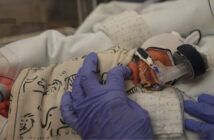(Photo | Unsplash)
Fifteen years back, the idea of robots in the workplace outside of manufacturing was seen as far-fetched or an anomaly. Then Amazon bought Kiva Systems, a robotic company, and started massive deployments in their warehouses. Fast-forward to January 2020 and Amazon’s deployed 200,000 robots. There are autonomous robotic drones monitoring herds, crops and borders. Robots are delivering packages and groceries, restocking supplies in hospitals. Restaurants are using them to make hamburgers and other meals without human intervention. Security companies use them to monitor parking lots and large venues.
Now move the clock to today amidst the raging pandemic, a moment when humans are concerned about exposure and think twice about close interaction with humans (at least the sane ones do). Robots are a sterile workforce, work 24/7 and can be sterilized as frequently as needed.
A robotics company, Diligent Robots, created a mobile robot called Moxi that is autonomous and socially intelligent. Its initial market entry was as a healthcare support robot. Moxi’s role is not to replace healthcare workers such as nurses, rather to support them by doing mundane, repetitive work such as restocking supplies, removing soiled linen bags and delivering lab samples. There is a systemic shortage of nurses in our country, which existed way before the pandemic struck. Moxi is one solution to free up nurses to perform more important patient-focused services.
Another robotics company, UVD Robots, autonomously rolls through rooms and hallways disinfecting areas using ultraviolet lights. Its targets are infectious diseases, vira (ex. COVID-19), bacteria and other types of harmful organic microorganisms, killing them by breaking down their DNA-structure. Its use to disinfect COVID-19 patient rooms is a huge relief to overstressed hospital staff.
A Chinese AI/robotics company, Shenzhen MicroMultiCopter, recently announced it has deployed more than 100 autonomous robotic drones in several Chinese cities outfitted with thermal sensors that can read people’s temperatures identifying possible COVID-19 infections and can also spray disinfectant in open spaces.
Amazon’s investment in robots has not slowed its hiring frenzy for warehouse workers. The robotic strategy is to free up human workers to focus on tasks that require human-level judgement which robots currently have difficulty doing. Instead of staff walking aisles to locate and pick products off the racks, powerful robots move the racks to the humans. Besides speeding up warehouse processes, it reduces worker injuries and fatigue. Additionally, it reduces the area and objects humans infect with their breath and touch. With closely monitored fixed worker station areas, COVID-19 cleansing and disinfecting are done more efficiently and thoroughly.
Now back to our pandemic. Will people normalize the experience of coexisting with robotic assistants in the workplace and retail establishments? Studies monitoring autonomous robots roaming in close proximity with humans in retail outlets, warehouses and outdoor venues indicate humans quickly adapt to their presence. There are robots counting inventory and sharing aisles with people in grocery stores. One such robot is Walmart’s fleet of Bossa Nova robots in 350 stores (as of January 2020) and rolling out to at least 1,000. At first, people were startled and confused and might reroute to avoid one. After months of encounters, shoppers just ignored them and were not concerned as a robot maneuvered around them and their shopping carts. Large retailers are starting to deploy robots such as Moxi to help disinfect the air, shelves and products.
A relevant field of study in robotics is known as Human-robot Interaction (“HRI”), which owes its existence to Isaac Asimov’s novel, I Robot, published in 1950. Asimov famously crafted the Three Laws of Robotics:
- A robot may not injure a human being or, through inaction, allow a human being to come to harm.
- A robot must obey the orders given it by human beings, except where such orders would conflict with the First Law.
- A robot must protect its own existence, as long as such protection does not conflict with the First or Second Law.
These original laws (there are a few new ones) are considered the foundation for crafting the AI engines that animate the robots of today. Tesla’s Autopilot and Full Self-Driving capability is based on algorithms with these principles at their core, and, just like in I Robot, it grapples with the dilemmas such as those featured in the book. One example is the “least worst” problem. If a Tesla car tries to avoid a collision with one vehicle, say with a busload of children, but results in plowing through a group of pedestrians as the only alternative, which one does it choose? If a third alternative is to go over a cliff and kill the car’s passengers, will it consider killing the occupants as the least worst? Just to be clear, if a human were driving, the choices would be the same, however self-preservation would no doubt eliminate the third option.
If robots are given a level of autonomy to combat the spiraling COVID-19 spread, will it be given the power to disburse crowds, issue citations for violating distancing laws, scan people’s faces and temperatures and notify authorities? How will we feel about a robot interjecting itself so intrusively in our daily lives?
As more robots hit the aisles and streets to combat the pandemic and become part of the background noise in our lives, the more we will accept them as we did with cell phones in the late 90s and earbuds in recent years. However, I can see the headlines screaming about the “injustice” of having robots taking steps to protect the majority by hassling those who may be, or at risk of being, infected. I, for one, am ready to have benevolent robots help us keep everyone healthy and safe.
Find Out More
digitalrobots.com; uvd-robots.com; mmcuav.com; bit.ly/Amazon-Robots; bit.ly/TechCrunch-Walmart-Robots
Preston Callicott is CEO of Five Talent Software, Inc. based in Bend. His hope is writing articles such as this one will allow his mind to stop waking him up at 4am with “aha’s” and “oh-my’s” about the massive impact tech has on our collective future.





